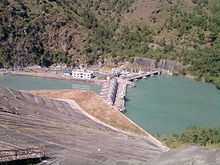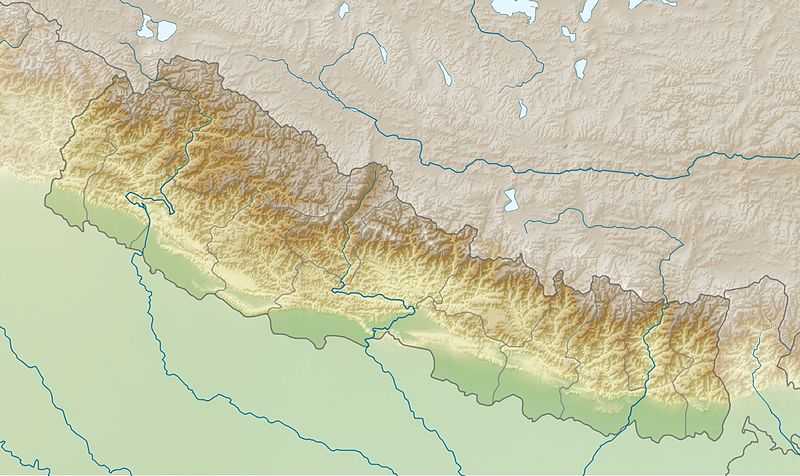Kaligandaki A Hydroelectric Power Station
| Kaligandaki A Dam | |
|---|---|
 The dam; intake (bottom), spillway (top) | |
 | |
| Official name | Kaligandaki A Hydroelectric Power Station |
| Country | Nepal |
| Location | Mirmi, Syangja |
| Coordinates | 27°58′44.88″N 83°34′49.68″E / 27.9791333°N 83.5804667°ECoordinates: 27°58′44.88″N 83°34′49.68″E / 27.9791333°N 83.5804667°E |
| Purpose | Power |
| Status | Operational |
| Construction began | 1997 |
| Opening date | 2002 |
| Construction cost | US$354.8 million (50 billion Nepali Rupees) |
| Owner(s) | Nepal Electricity Authority |
| Dam and spillways | |
| Type of dam | Concrete gravity |
| Impounds | Gandaki River |
| Height | 44 m (144 ft) |
| Spillway type | Radial gated |
| Reservoir | |
| Total capacity | 7,700,000 m3 (6,200 acre·ft) |
| Surface area | 7.618 km2 (2.941 sq mi) |
| Power station | |
| Name | Kaligandaki A Hydroelectric Power Station |
| Coordinates | 27°55′51.39″N 83°36′54.34″E / 27.9309417°N 83.6150944°E |
| Operator(s) | Nepal Electricity Authority |
| Commission date | 2002 |
| Type | Run-of-the-river |
| Hydraulic head | 115 m (377 ft) |
| Turbines | 3 x 48 MW Francis-type |
| Installed capacity | 144 MW |
| Annual generation | 860 GWh |
Kaligandaki A Hydroelectric Power Station is situated near Mirmi of Syangja District about 300 km to the west of Kathmandu and 100 km from Pokhara in the same direction in Nepal. The dam and headworks are situated on the Gandaki River at the confluence of the Andhikhola whereas the power house is located downstream, around a bend in the river, in Beltari (About 7 km towards the South-East of Mirmi).[1][2][3] A 5.9 km (3.7 mi) long headrace tunnel connects the reservoir to the power station which contains three 48 MW Francis turbine-generators. Owner and operator of the power plant is Nepal Electricity Authority.
It is a run-of-river type of project and currently is the largest power plant of any kind in Nepal with an installed capacity of 144 MW. Construction started in the year 1997 and was completed in the year 2002. The three generators were commissioned in March, April and May 2002. It was constructed primarily to curb the ever increasing energy demand at that time and eliminate loadshedding prevalent due to the imbalance in demand and supply of energy. It was constructed with the financial aid of the Asian Development Bank with total costs reaching US$354.8 million (50 billion NPR (approx)).[4]
Transmission line
The power generated by the three turbines is evacuated to the central grid via a 132kV single circuit, a 66 kilometres (41 mi) long transmission line to Pokhara, and a 44 kilometres (27 mi) double circuit transmission line to Butwal. The electricity is sent to Lekhnath Municipality and Butwal (known as Butwal-1 and Butwal-2). A sub-station has been constructed in Lekhnath Municipality, Kaski district and the existing Jogikuti substation in Butwal has been upgraded.[5]
See also
References
- ↑ "Nepal: Kali Gandaki "A" Hydroelectric Project". adb.org. Retrieved 25 March 2014.
- ↑ "Kali Gandaki 'A' Hydropower Station". erg.com.np. Retrieved 25 March 2014.
- ↑ "List of Major Hydropower Stations in Nepal". bossnepal.com. Retrieved 25 March 2014.
|first1=missing|last1=in Authors list (help) - ↑ "Project Completion Report on the Kali Gandaki "A" Hydroelectric Project (Loan 1452-Nep[Sf]) in Nepal". Asian Development Bank. April 2004. Retrieved 1 March 2015.
- ↑ "Kali Gandaki ‘A’ Hydroelectric Project in Environmental Perspectives". aecen.org. Retrieved 25 March 2014.
| Wikimedia Commons has media related to Kali Gandaki A Dam. |